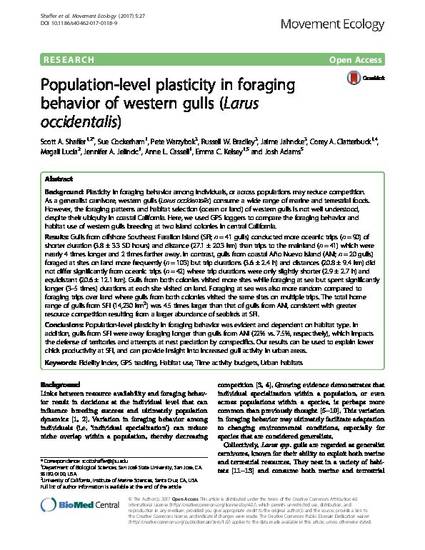
Article
Population-level plasticity in foraging behavior of western gulls (Larus occidentalis)
Movement Ecology
(2017)
Abstract
Background
Plasticity in foraging behavior among individuals, or across populations may reduce competition. As a generalist carnivore, western gulls (Larus occidentalis) consume a wide range of marine and terrestrial foods. However, the foraging patterns and habitat selection (ocean or land) of western gulls is not well understood, despite their ubiquity in coastal California. Here, we used GPS loggers to compare the foraging behavior and habitat use of western gulls breeding at two island colonies in central California.
Results
Gulls from offshore Southeast Farallon Island (SFI; n = 41 gulls) conducted more oceanic trips (n = 90) of shorter duration (3.8 ± 3.3 SD hours) and distance (27.1 ± 20.3 km) than trips to the mainland (n = 41) which were nearly 4 times longer and 2 times farther away. In contrast, gulls from coastal Año Nuevo Island (ANI; n = 20 gulls) foraged at sites on land more frequently (n = 103) but trip durations (3.6 ± 2.4 h) and distances (20.8 ± 9.4 km) did not differ significantly from oceanic trips (n = 42) where trip durations were only slightly shorter (2.9 ± 2.7 h) and equidistant (20.6 ± 12.1 km). Gulls from both colonies visited more sites while foraging at sea but spent significantly longer (3–5 times) durations at each site visited on land. Foraging at sea was also more random compared to foraging trips over land where gulls from both colonies visited the same sites on multiple trips. The total home range of gulls from SFI (14,230 km2) was 4.5 times larger than that of gulls from ANI, consistent with greater resource competition resulting from a larger abundance of seabirds at SFI.
Conclusions
Population-level plasticity in foraging behavior was evident and dependent on habitat type. In addition, gulls from SFI were away foraging longer than gulls from ANI (22% vs. 7.5%, respectively), which impacts the defense of territories and attempts at nest predation by conspecifics. Our results can be used to explain lower chick productivity at SFI, and can provide insight into increased gull activity in urban areas.
Keywords
- Fidelity index,
- GPS tracking,
- Habitat use,
- Time activity budgets,
- Urban habitats
Disciplines
Publication Date
December 19, 2017
DOI
10.1186/s40462-017-0118-9
Publisher Statement
This article was published in Movement Ecology, (2017), 5:27.
© The Author(s). 2017 Open Access This article is distributed under the terms of the Creative Commons Attribution 4.0 International License (http://creativecommons.org/licenses/by/4.0/), which permits unrestricted use, distribution, and reproduction in any medium, provided you give appropriate credit to the original author(s) and the source, provide a link to the Creative Commons license, and indicate if changes were made. The Creative Commons Public Domain Dedication waiver (http://creativecommons.org/publicdomain/zero/1.0/) applies to the data made available in this article, unless otherwise stated.
Citation Information
Scott A Shaffer, Sue Cockerham, Pete Warzybok, Russell W. Bradley, et al.. "Population-level plasticity in foraging behavior of western gulls (Larus occidentalis)" Movement Ecology Vol. 5 (2017) ISSN: 2051-3933 Available at: http://works.bepress.com/scott_shaffer/57/
Creative Commons license

This work is licensed under a Creative Commons CC_BY International License.
